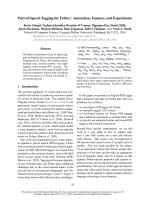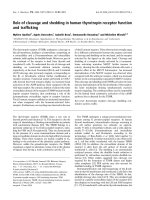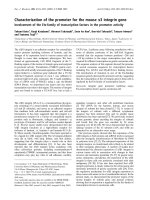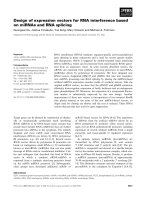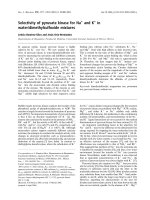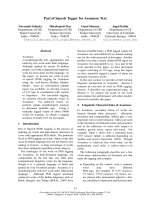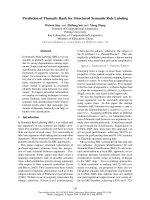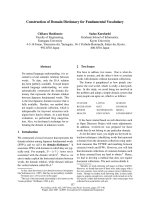Báo cáo khoa học: "Estimation of energy requirements for mechanically ventilated, critically ill patients using nutritional status" pdf
Bạn đang xem bản rút gọn của tài liệu. Xem và tải ngay bản đầy đủ của tài liệu tại đây (77.56 KB, 8 trang )
Introduction
Sufficient nutrients are needed for critically ill patients to meet
metabolic needs. Previous studies have shown that appropri-
ate nutritional feeding during critical illness improves the
success in weaning patients from mechanical ventilation and
in reducing the length of hospitalization [1–5]. Underfeeding
R108
Critical Care October 2003 Vol 7 No 5 Kan et al.
Research
Estimation of energy requirements for mechanically ventilated,
critically ill patients using nutritional status
Mee-Nin Kan
1
, Han-Hsin Chang
2
, Woei-Fen Sheu
3
, Chien-Hsiang Cheng
4
, Bor-Jen Lee
5
and
Yi-Chia Huang
6
1
Chief, Intensive Care Unit, Taichung Veterans General Hospital, Taichung, Taiwan, ROC
2
Assistance Professor of School of Nutrition, Chung Shan Medical University, Taichung, Taiwan, ROC
3
Dietitian, Department of Food and Nutrition, Taichung Veterans General Hospital, Taichung, Taiwan, ROC
4
Attending of Critical Care and Respiratory Therapy, Taichung Veterans General Hospital, Taichung, Taiwan, ROC
5
Attending of Intensive Care Unit, Taichung Veterans General Hospital, Taichung, Taiwan, ROC
6
Dean and Professor of Institute of Nutritional Science, School of Nutrition, Chung Shan Medical University, Taichung, Taiwan, ROC
Correspondence: Yi-Chia Huang,
AF = appropriate feeding; APACHE = Acute Physiology and Chronic Health Evaluation; ICU = intensive care unit; MAC = mid-arm circumference;
MEE = measured energy expenditure; MI = Maastricht Index; NRI = Nutritional Risk Index; OF = overfeeding; RQ = respiratory quotient; TLC = total
lymphocyte count; TSF = triceps skinfold thickness; UF = underfeeding; UUN = urine urea nitrogen.
Abstract
Background There is very little information on what is considered an adequate energy intake for
mechanically ventilated, critically ill patients. The purpose of the present study was to determine this
energy requirement by making use of patients’ nutritional status.
Methods The study was conducted in a multidisciplinary intensive care unit of Taichung Veterans
General Hospital, Taiwan. Patients were hemodynamically stable and not comatose, and were
requiring at least 7 days of mechanical ventilation. Fifty-four patients successfully completed this study.
The resting energy expenditure was measured using indirect calorimetry. The total energy requirement
was considered 120% of the measured energy expenditure. The daily nutrient intake was recorded.
Nutritional status was assessed using single and multiple parameters, nitrogen balance, and medical
records, and was performed within 24 hours of admission and after 7 days in the intensive care unit.
Results Fifteen patients were being underfed (< 90% of total energy requirement), 20 patients were in
the appropriate feeding (AF) group (within ± 10% of total energy requirement), and 19 patients received
overfeeding (> 110% of total energy requirement). Patients in the underfeeding group received only
68.3% of their energy requirement, while the overfeeding group patients received up to 136.5% of their
required calories. Only patients in the AF group had a positive nitrogen balance (0.04 ± 5.1) on day 7.
AF group patients had a significantly higher Nutritional Risk Index value at day 7 than at day 1.
Conclusion AF patients had more improvement in nutritional status than patients in the other feeding
groups. To provide at least 120% of the resting energy expenditure seemed adequate to meet the
caloric energy needs of hemodynamically stable, mechanically ventilated, critically ill patients.
Keywords appropriate feeding, critically ill, energy requirement, nutritional status, overfeeding, underfeeding
Received: 25 April 2003
Revisions requested: 16 July 2003
Revisions received: 5 August 2003
Accepted: 5 August 2003
Published: 28 August 2003
Critical Care 2003, 7:R108-R115 (DOI 10.1186/cc2366)
This article is online at />© 2003 Kan et al., licensee BioMed Central Ltd
(Print ISSN 1364-8535; Online ISSN 1466-609X). This is an Open
Access article: verbatim copying and redistribution of this article are
permitted in all media for any purpose, provided this notice is
preserved along with the article's original URL.
Open Access
R109
Available online />(UF) decreases the regeneration of respiratory epithelium and
causes respiratory muscular weakness [6], and it may prolong
mechanical ventilation by failing to restore respiratory muscle
strength and endurance. Overfeeding (OF), in contrast,
increases physiological stress and also prolongs mechanical
ventilation by increasing carbon dioxide production, which
increases the amount of ventilation necessary to maintain a
steady state of arterial blood gases [7]. Unfortunately, severe
protein-caloric malnutrition is still a major problem in many crit-
ically ill patients. Our previous study [8] even showed that
94% of intensive care unit (ICU) patients were malnourished
after 14 days of admission. It thus becomes very important to
determine adequate and appropriate energy needs for
mechanically ventilated, critically ill patients.
Although appropriate feeding (AF) is required for mechani-
cally ventilated, critically ill patients, there is very little informa-
tion on the energy requirement for these patients. The
purpose of the present study was to determine the energy
requirement for mechanically ventilated, critically ill patients
using the nutritional status.
Patients and methods
Patients
This study was conducted in the ICU of Taichung Veterans
General Hospital, a 1359-bed teaching hospital in the central
part of Taiwan. The study was approved by the Institutional
Review Board of Chung Shan Medical University. Informed
consent was obtained. Only patients that were hemodynami-
cally stable and not comatose, and requiring at least 7 days of
mechanical ventilation, were included.
Patients were excluded when they received a fraction of
inspired oxygen > 60% at the time of indirect calorimetry mea-
surement. Oliguric patients were also excluded since abnor-
mal renal function would not give a 24-hour urine volume of
sufficient steady state for confidence in values for urinary nitro-
gen excretion. One hundred and eighteen patients entered the
present study. However, only fifty-four patients (40 men,
14 women) successfully completed the study. Medical
records including diagnosis, severity of illness, length of ICU
stay and length of hospital stay, and ventilatory dependency
were obtained. The severity of illness of these patients was
evaluated by the Acute Physiology and Chronic Health Evalua-
tion (APACHE) II score [9] on day 1 and day 7 of admission.
Energy requirements and nutrient intakes
The Deltatrac™ II MBM-200 Metabolic Monitor (Datex-
Engstrom Division, Instrumentation Corp., Datex-Engstrom,
Finland) was used to measure the actual energy expenditure
(measured energy expenditure [MEE]) of patients on two
occasions during the study (day 1 and day 6 or 7 of the
study). The MEE was based on a single measure taken on
day 1 and thereafter used as the goal. The Deltatrac™ II
MBM-200 Metabolic Monitor can be used to perform indirect
calorimetry with most commonly used ventilators.
Patients were without intermittent caloric intake for at least
4 hours prior to the indirect calorimetry measurement.
However, patients receiving continuous enteral or parenteral
infusions were not interrupted during the measurement. The
patient was connected via an endotracheal tube to a spirome-
ter filled with 100% O
2
attached to a kymograph. As the
patient breathed, the oxygen was consumed and CO
2
was
exhaled. The water and CO
2
vapor were mechanically
absorbed, so that volume changes in the spirometer were
only due to the consumption of oxygen. The oxygen uptake by
the lungs was determined from the amount of oxygen con-
sumed from the spirometer. All measurements were per-
formed by one trained technician. The flowmeter, and the
CO
2
and O
2
analyzers are automatically calibrated before
each measurement. Patients’ oxygen consumption was mea-
sured for at least 40 min each time. Nitrogen excretion data
was not available for nine patients. The Weir equation [10],
which assumes that 12.3% of the total calories arise from
protein metabolism, was then used to calculate nitrogen
excretion. The total energy requirement was considered the
MEE plus a 5% activity factor [11,12] and plus 15% for day-
to-day variability [13].
Patients received nutrition support (enteral nutrition, total par-
enteral nutrition, or combined enteral nutrition plus total par-
enteral nutrition), which was based on the physicians’
concerns for the clinical conditions of the patient. The com-
position of tube feeding formulas was prepared from various
commercial products based on the patient’s nutritional
needs. The daily macronutrient (carbohydrate, protein, and
fat) intake from nutritional support (enteral or parenteral nutri-
tion) and the intravenous crystalloid infusions were recorded
routinely by the ICU nurses and dietitians during the study.
The amount of nutrient intake represented in the result was
the mean amount of feed delivered in each group daily, up to
and including the day of assessment. All of the nonfeed
sources of macronutrients were also included in the calcula-
tions. Subjects were then divided into three groups based on
the degree of feeding (UF, AF, and OF) as previously
described [14]. UF was defined as a subject’s actual average
energy intake being less than 90% of total energy require-
ments. AF was defined as a subject’s actual average energy
intake being within ± 10% of total energy requirements. For
OF, the actual average energy intake was larger than 110%
of the total energy requirements.
Nutritional status assessment
Nutritional status was assessed within 24 hours of admission
and after 7 days in the ICU by the trained technician. The
patients’ nutritional status was determined from anthropomet-
ric and biochemical measurements, and from medical records.
Anthropometric measurements included patients’ height and
weight on admission, triceps skinfold thickness (TSF), and
mid-arm circumference (MAC). All the anthropometric mea-
surements were performed by one trained technician. The
R110
Critical Care October 2003 Vol 7 No 5 Kan et al.
body mass index, mid-arm muscle circumference, and arm
muscle area were then calculated: body mass index = weight
(kg)/height
2
(m), mid-arm muscle circumference (mm) = MAC
(mm) – (TSF [mm] ×3.14), and arm muscle area (mm
2
)=
(MAC [mm] – [TSF × 3.14])
2
/4π.
Biochemical measurements included serum albumin and pre-
albumin, and total lymphocyte count (TLC). A 24-hour urine
collection was obtained from patients for measurement of
urine urea nitrogen (UUN) and of creatinine. The creatinine
height index was calculated from 24-hour urinary creatinine
excretion [15]. The nitrogen balance was derived from the
daily volume of infusate minus the daily output of urinary nitro-
gen: nitrogen balance (g/day) = nitrogen intake – (UUN + 4g
obligatory loss). The following values were considered normal
for our laboratory: serum albumin, 3.5–5.0 g/dl; prealbumin,
18–43 mg/dl; TLC >1500/mm
3
; and creatinine height index
> 90%.
Two multiparameter nutritional status indices, the Maastricht
Index (MI) [16] and the Nutritional Risk Index (NRI) [17], were
also used to assess the nutritional status of patients. The MI
was calculated as follows: MI = 20.68 – (0.24× albumin [g/l])
– (19.21 × prealbumin[g/l]) – (1.86 × lymphocytes [10
9
/l]) –
(0.04 × percentage ideal weight). Patients with MI> 0 were
considered malnourished. The NRI was developed to assess
malnutrition of surgical patients: NRI = (15.9× plasma
albumin [g/dl]) + 41.7 ×(present weight / usual weight). A
value of NRI > 100 indicates that the subject is not malnour-
ished, 97.5–100 indicates the subject is mildly malnourished,
83.5 to < 97.5 indicates that the subject is moderately mal-
nourished, and NRI < 83.5 indicates that the subject is
severely malnourished.
Statistical analyses
Data were analyzed using the SigmaStat statistical software
(version 2.03; Jandel Scientific, San Rafael, CA, USA). Dif-
ferences in patients’ anthropometric and biochemical values,
nutritional status indices, and clinical outcome among
groups were compared for significant differences using one-
way analysis of variance. The Student t test was used to
compare the difference between day 1 and day 7 within a
group. Pearson correlation coefficients were determined to
assess the relationship between energy requirement, nutri-
ent intake, and clinical results. Statistical results were con-
sidered significant at P ≤ 0.05. Values are presented as
means ± standard deviation.
Results
Characteristics of patients
Fifteen patients (14 men, one woman) were being underfed,
20 patients (17 men, three women) were in the AF group, and
19 patients (11 men, eight women) were overfed while they
were in the ICU. Patients’ ages ranged from 23 to 89 years,
with a mean age of 61.9 ± 14.6 years, 68.0 ± 14.1 years and
72.2 ± 2.1 years for the UF group, the AF group and the OF
group, respectively. There were no statistically significant dif-
ferences among groups for age, height, and weight at admis-
sion. The diagnoses of patients at the time of admission in the
ICU are presented in Table 1. The most common diagnoses
were gastrointestinal disorders, malignant neoplasms, and
pneumonia.
Energy requirements versus energy intakes
The type of feeding route, values of the respiratory quotient
(RQ), the MEE, the total energy requirements and the nutrient
intake are presented in Table 2. UF patients were more likely
to be receiving combined nutrition (n = 8), while AF and OF
patients were more likely to be receiving enteral (n = 7) and
combined (n = 7) nutrition. OF patients had a mean RQ value
greater than 1. UF patients had the highest MEE and total
energy requirement.
It is not surprising to find OF patients consuming significantly
more calories than the other two groups. UF patients
received, on average, only 68.3% of their energy require-
ments, while OF patients received up to 136.5% of their esti-
mated caloric requirements. The energy intake of the OF
patients was more than 40 kcal/kg per day on average.
Looking at the individual data, three AF patients and nine OF
patients had an energy intake of more than 40 kcal/kg per
day. OF patients had a higher energy intake attributed to car-
bohydrate and fat, but not to protein. There was no significant
difference, however, in the percentage of energy intakes from
carbohydrate, protein, and fat.
OF patients received a significantly higher carbohydrate
intake than the other two groups when intake is expressed
per kilogram of body weight, although there was no signifi-
cant difference in total carbohydrate intake among the three
Table 1
Diagnosis of patients at the time of admission in the intensive
care unit
Underfeeding Appropriate Overfeeding
(n = 15) feeding (n = 20) (n = 19)
Respiratory disease 2 1 5
Gastrointestinal disorder 5 9 7
Malignant neoplasms 6 4 4
Infection 0 4 2
Trauma 1 2 1
Burn 1 0 0
Respiratory diseases include pneumonia; gastrointestinal disorders
include peptic ulcers, enteritis, acute pancreatitis, acute cholecystitis,
gastric ulcers, duodenal ulcers, peritonitis, and intestinal obstructions;
malignant neoplasms include esophageal tumors, hypopharyngeal
tumors, and colon cancer; infection includes deep neck infections, viral
meningitis, and acute maxillary sinusitis; trauma includes pelvic open
fractures, and diaphragm ruptures.
R111
groups. It is worth noting that UF patients had a carbohydrate
intake of more than 60% of the total calories. There was no
significant difference in protein intake among the three
groups. UF and AF patients had a mean protein intake of less
than 1.2 g/kg per day. Five UF patients (33.3%), six AF
patients (30%), and two OF patients (10.5 %) had an even
lower protein intake, less than 0.8 g/kg per day. UF patients
had a significantly lower fat intake than the OF patients. The
percentage of calories from fat for all three groups was less
than 30%.
Nutritional status assessment
Anthropometric measurements on day 1 and day 7 after
admission to the ICU are presented in Table 3. The mean
current weight did not significantly change during the study.
On day 7 in the ICU, UF patients showed significant reduc-
tions in MAC, mid-arm muscle circumference, and arm
muscle area when compared with that at day 1. AF and OF
patients, however, showed slight increases in weight, body
mass index and TSF at day 7.
The results of biochemical measurements are also presented
in Table 3. The albumin, prealbumin and TLC levels were, on
average, below normal for patients in all three groups.
Patients in all groups showed no significant changes in
albumin, prealbumin and TLC by day 7. The mean percentage
of the creatinine height index was less than 90% in the three
groups, with no significant changes when comparing day 1
and day 7. Patients in the three groups had negative nitrogen
balance at admission. Only AF patients showed a positive
nitrogen balance on day 7.
The MI was calculated based on albumin, prealbumin, TLC,
and percentage ideal body weight to classify patients as mal-
nourished or nonmalnourished (Fig. 1). On day 1 and day 7 in
the ICU, the MI values were 7.1 ± 1.5 versus 6.5± 2.4,
7.1 ± 2.3 versus 5.7± 2.5, and 8.2 ± 3.7 versus 8.8± 4.1 for
patients in the UF group, the AF group, and the OF group,
respectively. All patients had MI > 0 when admitted and on
day 7, which indicates that patients were malnourished. There
were no significant differences for the MI values on day 1 and
Available online />Table 2
The type of feeding route, energy requirement and actual macronutrient intakes of patients
Underfeeding (n = 15) Appropriate feeding (n = 20) Overfeeding (n = 19)
Feeding route
Enteral nutrition (number of subjects) 2 7 7
Parenteral nutrition (number of subjects) 5 6 5
Combined nutrition (number of subjects) 8 7 7
Energy expenditure
Respiratory quotient 0.91 ± 0.19
b
0.97 ± 0.12
a,b
1.16 ± 0.32
a
Measured energy expenditure* (kcal/day) 1878.9 ± 359.5
a
1572.0 ± 256.0
b
1272.4 ± 194.9
c
Total energy requirement
†
(kcal/day) 2254.7 ± 431.3
a
1886.4 ± 307.2
b
1526.9 ± 233.8
c
Total energy requirement
†
(kcal/kg/day) 35.7 ± 7.3 30.6 ± 6.9 30.6 ± 7.0
Nutrient intake
Energy (kcal) 1541.1 ± 305.9
b
1869.6 ± 303.4
a
2084.9 ± 448.9
a
Energy (kcal/kg per day) 24.9 ± 6.0
b
30.3 ± 7.4
b
41.5 ± 11.5
a
Carbohydrate (g) 246.4 ± 61.8 273.9 ± 77.3 304.3 ± 84.4
Carbohydrate (g/kg per day) 4.0 ± 1.1
b
4.4±1.3
b
6.0±1.7
a
% of total energy 63.7 ± 10.4 58.5 ± 11.1 58.0 ± 6.2
Protein (g) 59.8 ± 16.8 68.1 ± 22.7 66.4 ± 16.3
Protein (g/kg per day) 1.0 ± 0.3 1.1 ± 0.5 1.3 ± 0.5
% of total energy 16.3 ± 6.6 14.7 ± 5.2 12.9 ± 2.4
Fat (g) 42.2 ± 20.7
b
57.0 ± 19.1
a,b
66.7 ± 11.8
a
Fat (g/kg per day) 0.7 ± 0.4
b
0.9±0.3
b
1.4±0.5
a
% of total energy 24.2 ± 10.9 27.7 ± 9.0 29.5 ± 5.7
Values presented as mean ± standard deviation. Values in a row with different superscript letters are significantly different, P ≤ 0.05.
*Resting energy expenditure was measured using indirect calorimetry.
†
Total energy requirement = measured energy expenditure + physical activity (5%) + day-to-day variation (15%).
R112
day 7 among the three groups. Patients in all groups were
classified as severely malnourishment based on the NRI on
day 1 and day 7 (Fig. 2). Only AF patients had a significantly
higher NRI value at day 7 than at day 1.
Clinical outcome
The clinical outcome including the severity of the disease
(APACHE II score), the length of hospital stay and the length of
ICU stay, and the length of ventilator dependence are presented
in Table 4. The severity of disease (APACHE II score) was not
significantly different among the three groups at admission and
7 days after. In addition, there were no statistically significant dif-
ferences among groups for length of ventilator dependency,
ICU stay, and hospital stay. The length of ventilator dependency
was significantly positively correlated with total energy intake
(r=0.494, P=0.03) only in the AF group. The length of ICU stay
was significantly positively correlated with carbohydrate intake
(r=0.525, P=0.02) also only in the AF group.
Critical Care October 2003 Vol 7 No 5 Kan et al.
Table 3
Anthropometric and biochemical measurements of patients
Underfeeding (n = 15) Appropriate feeding (n = 20) Overfeeding (n = 19)
Measurement Day 1 Day 7 Day 1 Day 7 Day 1 Day 7
Anthropometric measurements
Current weight (kg) 64.5 ± 11.1 62.9 ± 9.0 63.1 ± 13.0 63.9 ± 12.9 52.7 ± 7.9 56.6 ± 9.4
Body mass index (kg/m
2
) 23.7 ± 3.6 23.1 ± 3.1 23.8 ±4.2 24.1±4.6 21.1 ± 4.0 23.1 ± 5.5
Triceps skinfold (mm) 11.6 ± 5.8 10.3 ± 5.6 11.5 ± 5.1 12.0 ± 5.9 10.8 ± 5.4 11.7 ± 7.7
Mid-arm circumference (mm) 282.3 ± 33.4
a
259.5 ± 37.2
b
271.5 ± 38.0 273.5 ± 42.0 245.9±37.9 245.6±34.8
Mid-arm muscle circumference (mm) 245.8 ± 26.1
a
227.2 ± 27.0
b
235.5 ± 30.7 235.7 ± 32.6 212.0±29.5 208.8±30.9
Arm muscle area (mm
2
) 4861.7±998.9
a
4164.5±968.0
b
4485.8±1167.2 4503.2±1250.1 3641.7±988.2 3541.8±989.9
Biochemical measurements
Albumin (g/dl) 2.5 ± 0.2 2.4 ± 0.4 2.3 ± 0.5 2.5 ± 0.6 2.5 ± 0.6 2.4 ± 0.4
Prealbumin (mg/dl) 10.0 ± 2.8 10.5 ± 3.8 11.9 ± 6.5 11.5 ± 3.8 11.7 ± 6.9 14.1 ± 6.4
Total lymphocyte count (mm
3
) 727.3±651.7 1094.4 ±776.9 856.3± 994.4 1319.8±1080.4 1064.3±1305.0 915.0 ±478.8
Creatinine height index (%) 76.2 ± 25.9 70.7 ± 36.6 68.9 ± 24.2 57.1 ± 29.0 67.2 ± 25.1 66.4 ± 23.3
Nitrogen balance –6.7 ± 6.0 –7.6 ± 7.2 –2.8 ± 4.5 0.04 ± 5.1 –1.9 ± 5.1 –1.7 ± 4.3
Values presented as mean ± standard deviation.
Figure 1
The Maastricht Index at day 1 (white bar) and at day 7 (black bar) after admission to the intensive care unit for patients in the underfeeding,
appropriate feeding, and overfeeding groups.
Underfeeding Appropriate feeding Overfeeding
(n = 15)
(n = 20) (n = 19)
yes
no
malnourishment
Ma
a
s
t
r
i
c
h
t
I
n
d
e
x
1
st
day 7
th
day 1
st
day 7
th
day 1
st
day 7
th
day
–2
0
2
4
6
8
10
12
14
R113
Discussion
The prevalence of malnutrition is a common problem in criti-
cally ill patients who are being ventilated mechanically
[8,18–21]. Using single and multiple parameters to assess
nutritional status, results showed our critically ill patients were
in a severely malnourished state. Driver and LeBrun found
that nutritional support was inadequate in almost all cases,
reporting that only three out of 26 patients received sufficient
energy intake [22]. Sufficient energy and nutrient consump-
tion are needed for patients to improve their nutritional status
and to increase their immunity. In the critically care setting,
however, appropriate and adequate feeding is sometimes dif-
ficult. Previous studies [14,23] have shown that only
25–32% of patients received total calories within 10% of
their required needs. The present study showed a higher per-
centage of patients (37%) were fed appropriately; however,
there was still 28% and 35% of patients who were underfed
and overfed, respectively.
A RQ value greater than 1 indicates that patients have been
overfed. Indeed, the mean RQ value in the present AF and
OF patients was close to or greater than 1, which might indi-
cate a rise in CO
2
production. Looking at the distribution of
energy intake, the OF group received significantly higher
amounts of carbohydrate than the other two groups. Excess
carbohydrate intake leads to increasing CO
2
production,
which will delay success in weaning from mechanical ventila-
tion and will prolong the length of hospitalization [7,24,25].
The present result did show that carbohydrate intake posi-
tively correlated with the length of the ICU stay. Thus, when
there is a need for increasing energy intake, the energy
source should be carefully chosen to avoid giving excess car-
bohydrate calories.
The optimal protein requirement for critically ill patients has
been stated as 1.5–2.0 g/kg [26]. Smith and colleagues [27]
indicated that 300 mg/kg nitrogen intake (~1.8 g/kg protein)
Available online />Figure 2
The Nutritional Risk Index at day 1 (white bar) and at day 7 (black bar) after admission to the intensive care unit for patients in the underfeeding,
appropriate feeding, and overfeeding groups. * The value at day 7 is significantly different to that at day 1, P < 0.05.
Not malnourishment
Mild malnourishment
Moderate malnourishment
Severe malnourishment
Nutritional Risk Index
1
st
day 7
th
day 1
st
d 7
th
day 1
st
day 7
th
day
Underfeeding Appropriate feeding Overfeeding
(n = 15) (n = 20) (n = 19)
*
67.5
72.5
77.5
82.5
87.5
92.5
97.5
102.5
107.5
Table 4
Clinical outcome
Underfeeding (n = 15) Appropriate feeding (n = 20) Overfeeding (n = 19)
APACHE II score (day 1) 19.9 ± 5.2 17.4 ± 4.0 17.7 ± 3.9
APACHE II score (day 14) 19.1 ± 7.0 17.3 ± 4.6 16.3 ± 5.0
Length of hospital stay (days) 79.2 ± 50.5 77.3 ± 69.1 74.1 ± 25.0
Length of intensive care unit stay (days) 45.2 ± 25.0 39.1 ± 19.9 31.0 ± 6.6
Length of ventilatory dependence (day) 65.2±48.3 53.5 ± 28.1 58.0 ± 16.8
APACHE, Acute Physiology and Chronic Health Evaluation.
R114
was needed for gastroenterological patients to maintain nitro-
gen balance. Shaw and colleagues [28] showed, when provid-
ing 1.5 g/kg per day protein to severely septic patients, that
maximal stimulation of protein synthesis could be achieved.
Overall the present patients had a mean protein intake approxi-
mating 1.1 g/kg per day, which was obviously inadequate for
this critically ill population to achieve a positive nitrogen
balance. A negative nitrogen balance indicates protein catabo-
lism and reflects inadequate protein intake. The goal of nutrition
support is to achieve a nitrogen balance in the range of +2 to
+4 g/day [29]. It was therefore not surprising to find that our
patients had a negative nitrogen balance throughout the study.
The nitrogen balance reflects both protein and energy intake.
We suggested that nitrogen balance studies should be rou-
tinely performed in a critical care setting in order to return
patients back to an anabolic state. However, previous studies
have indicated that the UUN is too insensitive for determining
total urinary nitrogen, and would therefore interfere signifi-
cantly with nitrogen balance predictions [30–32]. Because
Kjeldahl nitrogen determination or pyrochemiluminescence
are generally not routinely performed in the clinical laboratory
in Taiwan, UUN was used as an estimate of total urinary nitro-
gen when we calculated the nitrogen output for the nitrogen
balance. However, we used full 24-hour urine collection
rather than spot samples to determine the UUN, and so a
more accurate calculation of UUN could thus be made [33].
However, the severity, duration and influence of nitrogen
balance on patients’ clinical outcome still cannot be
assessed from the data we collected. In addition, patients in
the UF group showed significant decreases in MAC, mid-arm
muscle circumference, and arm muscle area at day 7 in the
ICU, indicating that patients were significantly losing their
lean body mass and were in a catabolic state.
Previous authors have suggested adding approximately
20–25% to the resting energy expenditure for clinically stable
patients in order to calculate total energy requirements
[11–13]. In the present study, 20% was added to the resting
energy expenditure. Shortcomings of the present study
include the sample size and the length of observation
(7 days), which may not be sufficient time to see any signifi-
cant improvement in nutritional status in the critically ill.
However, only patients receiving total energy intakes
within ± 10% of 120% MEE achieved positive nitrogen
balance by the end of the study. In addition, AF patients
showed slight increases in body weight, body mass index,
and TSF after 7 days’ stay in the ICU, and a significantly
improved NRI value on day 7. We know that critically ill
patients with mechanical ventilation have greater fluid reten-
tion, not breathing spontaneously. They have more severe
clinical conditions, are more sedated, and are in a relatively
more motionless state than general hospitalized patients [34].
However, 120% MEE might be considered an appropriate
and adequate total energy requirement for mechanically venti-
lated, critically ill patients.
In conclusion, critically ill patients were in a severely malnour-
ished state. UF patients had more severe malnutrition than AF
or OF patients. AF patients showed more improvement in nutri-
tional status than patients in the other feeding groups. Provid-
ing at least 120% of the resting energy expenditure thus
seemed adequate to meet the caloric energy needs of hemody-
namically stable, mechanically ventilated, critically ill patients.
Competing interests
None declared.
References
1. Bassili HR, Deitel M: Effect of nutritional support on weaning
patients off mechanical ventilators. J Parenter Enteral Nutr
1981, 5:161-163.
2. Larca L, Greenbaum DM: Effectiveness of intensive nutritional
regimes in patients who fail to wean from mechanical ventila-
tion. Crit Care Med 1982, 10:297-300.
3. Askanazi J, Starker PM, Olsson C, Hensle TW, Lockhart SH,
Kinney JM, La Sala PA: Effect of immediate postoperative nutri-
tional support on length of hospitalization. Ann Surg 1986, 2:
236-239.
4. Benotti PN, Bistran B: Metabolic and nutritional aspects of
weaning from mechanical ventilation. Crit Care Med 1989, 17:
181-185.
5. Garrel DR, Davignon I, Lopez D: Length of care in patients with
severe burns with or without early enteral nutritional support.
J Burn Care Rehabil 1991, 12:85-90.
6. Askanazi J, Weissman C, Rosenbaum SH, Hyman AI, Milic-Emili J:
Nutrition and the respiratory system. Crit Care Med 1982, 10:
163-172.
7. Dark DS, Pingleton SK, Kerby GR: Hypercapnia during
weaning: a comparison of nutritional support. Chest 1985, 88:
141-143.
8. Huang YC, Yen CL, Cheng CH, Jih KS, Kan MN: Nutritional
status of mechanically ventilated critically ill patients: compar-
ison of different type of nutritional support. Clin Nutr 2000, 19:
101-107.
9. Knaus WA, Draper EA, Wagner DP, Zimmerman JE: APACHE II:
a severity of disease classification system. Crit Care Med
1985, 13:818-829.
10. Weir JB de V: New methods for calculating metabolic rate with
special reference to protein metabolism. J Physiol 1941, 109:
1-9.
11. Swinamer DL, Phang PT, Jones RL, Grace M, King EG: Twenty-
four hour energy expenditure in critically ill patients. Crit Care
Med 1987, 15:637-643.
12. Weissman C, Kemper M, Elwyn DH, Askanazi J, Hyman AI, Kinney
JM: The energy expenditure of the mechanically ventilated
critically ill patient: an analysis. Chest 1986, 89:254-259.
Critical Care October 2003 Vol 7 No 5 Kan et al.
Key messages
• Only patients in the appropriate feeding group
improved their nitrogen balance positively by day 7 of
admission, and had a significantly higher Nutritional
Risk Index at day 7 than on day 1
• Patients in the appropriate feeding group had a greater
improvement in nutritional status than patients in the
other feeding groups
• To provide at least 120% of the resting energy expen-
diture seemed adequate to meet the caloric energy
needs of hemodynamically stable, mechanically venti-
lated, critically ill patients
R115
13. Weissman C, Kemper M, Hyman AI: Variation in the resting
metabolic rate of mechanically ventilated critically ill patients.
Anesthesia Analgesia 1989, 68:457-461.
14. McClave SA, Lowen CC, Kleber MJ, Nicholson JF, Jimmerson SC,
McConnell JW, Jung L: Are patients fed appropriately accord-
ing to their caloric requirements? J Parenter Enteral Nutr 1998,
22:375-381.
15. Bistrian BR, Blackburn GL, Sherman M, Scrimsaw NS: Thera-
peautic index of nutritional depletion in hospitalized patients.
Surg Gynecol Obstet 1975, 141:512-516.
16. de Jong PCM, Wesdorp RIC, Volovics A, Roufflart M, Greep JM,
Soeters PB: The value of objective measurements to select
patients who are malnourished. Clin Nutr 1985, 4:61-66.
17. Hall JC: The use of internal validity in the construct of an index
of undernutrition. J Parenter Enteral Nutr 1990, 14:582-587.
18. Driver AG, Le Brun M: Iatrogenic malnutrition in patients
receiving ventilatory support. JAMA 1980, 244:2195-2196
19. Bassili HR, Deitel M: Effect of nutritional support on weaning
patients off mechanical ventilators. J Parenter Enteral Nutr
1981, 5:161-163.
20. Larca L, Greenbaum DM: Effectiveness of intensive nutritional
regimes in patients who fail to wean from mechanical ventila-
tion. Crit Care Med 1982, 10:297-300.
21. Christman JW, McCain RW: A sensible approach to the nutri-
tional support of mechanically ventilated critically ill patients.
Intensive Care Med 1993, 19:129-136.
22. Driver AG, LeBrun M: Iatrogenic malnutrition in patients receiv-
ing ventilatory support. JAMA 1980, 244:2195-2196.
23. Makk LJ, McClave SA, Creech PW, Johnson DR, Short AF,
Whitlow NL, Priddy FS, Sexton LK, Simpson P: Clinical applica-
tion of the metabolic cart to the delivery of total parenteral
nutrition. Crit Care Med 1990, 18:1320-1327.
24. Covelli HD, Black JW, Olsen MS, Beekman JF: Respiratory
failure precipitated by high carbohydrate loads. Ann Intern
Med 1981, 95:579-581.
25. Askanazi J, Rosenbaum SH, Hyman AI, Silverberg PA, Milic-Emili
J, Kinney JM: Respiratory changes induced by the large
glucose loads of total parenteral nutrition. JAMA 1980, 243:
1444-1447.
26. ASPEN Board of Directions: Guidelines for the use of par-
enteral and enteral nutrition in adult and pediatric patients.
J Parenter Enteral Nutr 1993, 17(Suppl):1-52.
27. Smith RC, Burkinshaw L, Hill GL: Optimal energy and nitrogen
intake for gastroenterological patients requiring intravenous
nutrition. Gastroenterology 1982, 82:445-452.
28. Shaw JHF, Wildbore M, Wolfe RR: Whole body protein kinetics
in severely septic patients: the response to glucose infusion
and total parenteral nutrition. Ann Surg 1986, 205:288-294.
29. Case KO, Cuddy PG, McGurk EPD: Nutrition support in the
critically ill patient. Crit Care Nurs Q 2000, 22:75-89.
30. Konstantinides FN, Boehm KA, Radmer WJ, Storm MC, Adderly
JT, Weisdorf SA, Cerra FB: Pyrochemiluminescence: real-time,
cost-effective method for determining total urinary nitrogen in
clinical nitrogen-balance studies. Clin Chem 1988, 34:2518-
2520.
31. Loder PB, Kee AJ, Horsburgh R, Jones M, Smith RC: Validity of
urinary urea nitrogen as a measure of total urinary nitrogen in
adult patients requiring parenteral nutrition. Crit Care Med
1989, 17:309-312.
32. Konstantinides FN, Konstantinides NN, Li JC, Myaya ME, Cerra
FB: Urinary urea nitrogen: too insensitive for calculating nitro-
gen balance studies in surgical clinical nutrition. J Parenter
Enteral Nutr 1991, 15:189-193.
33. Ford EG, Jennings LM, Andrassy RJ: Hourly urine nitrogen
values do not reflect 24-hour totals in injured children. Nutr
Clin Pract 1987, 2:195-198.
34. Damask MC, Schwarz RY, Weissman C: Energy measurements
and requirements of critically ill patients. Crit Care Clin 1987,
3:71-96.
Available online />

